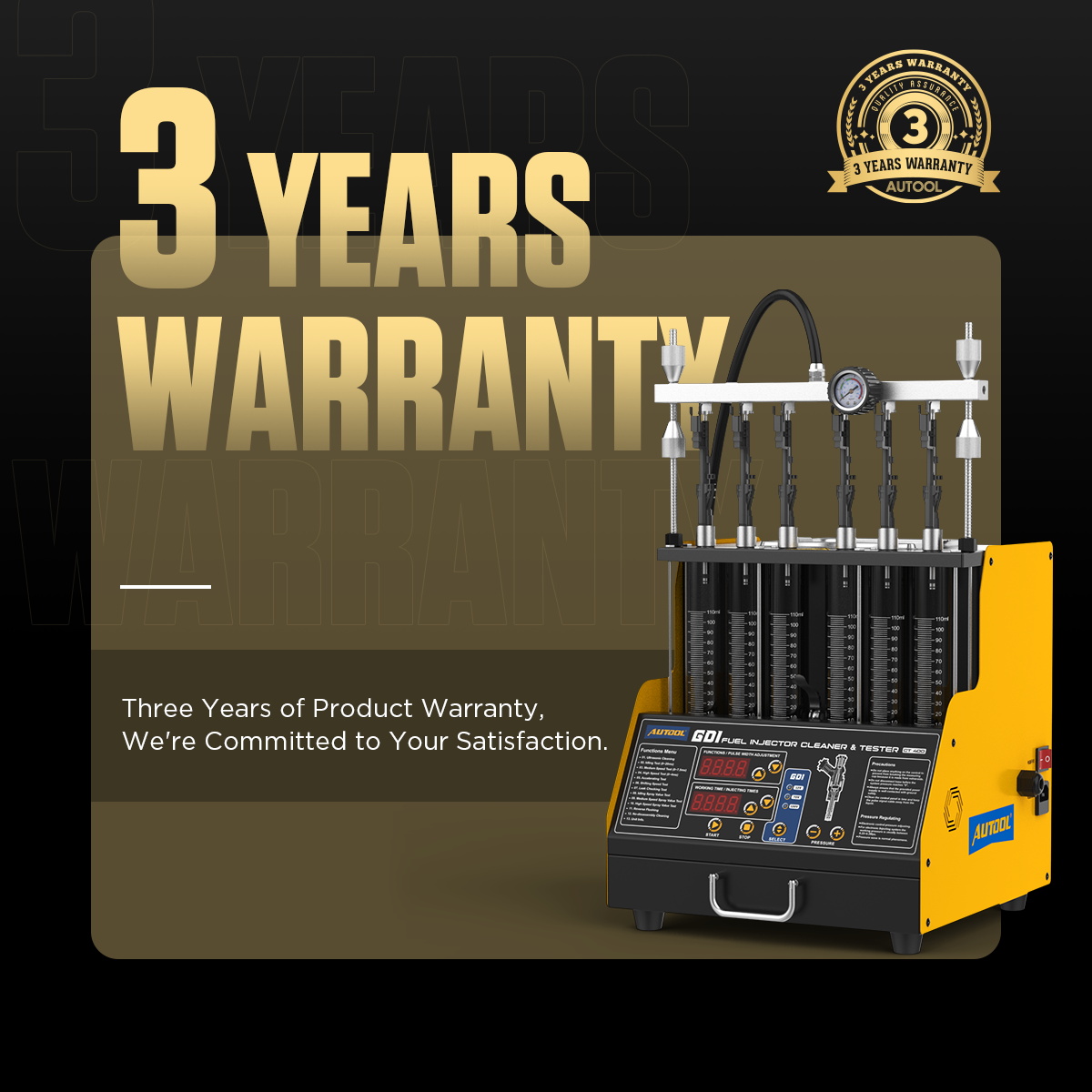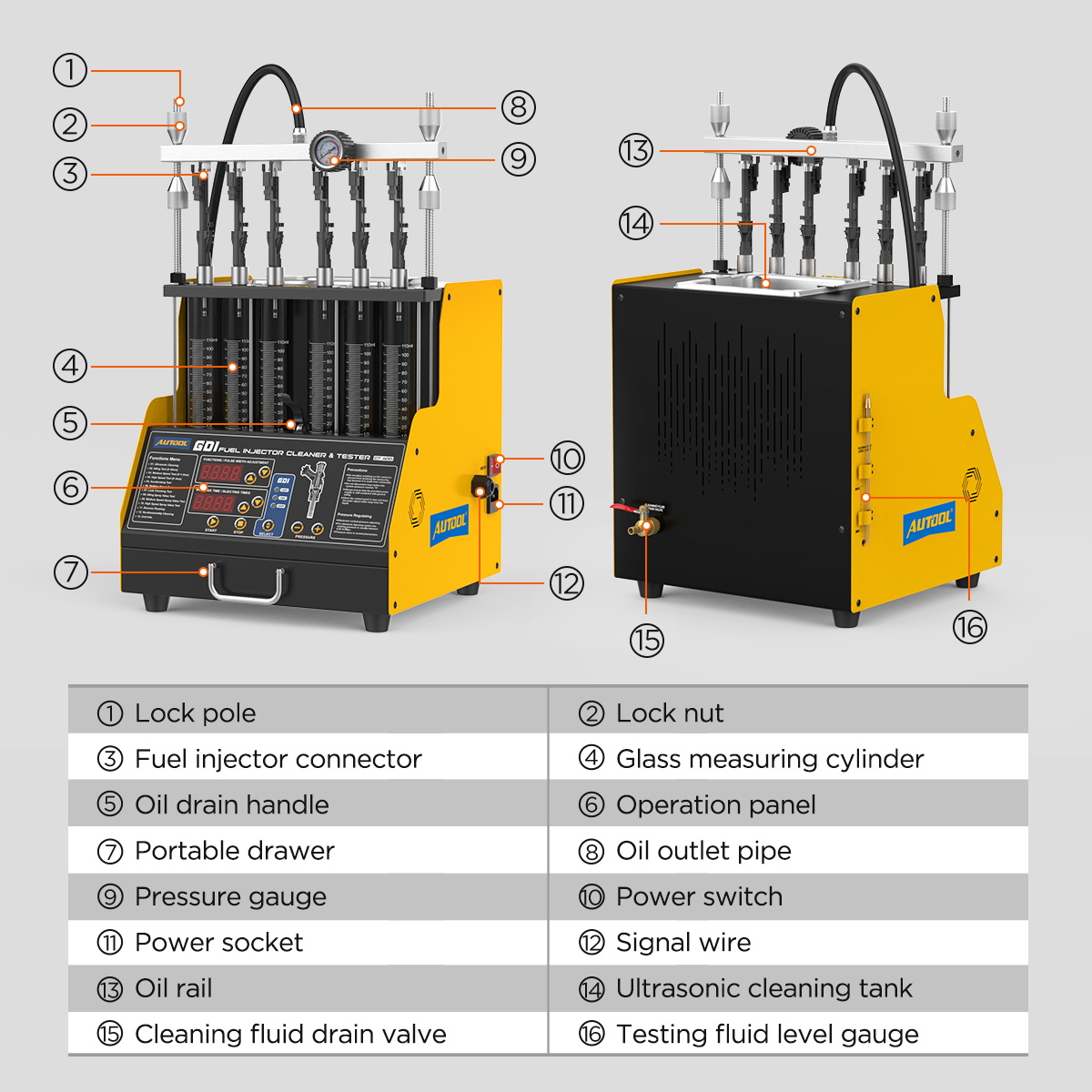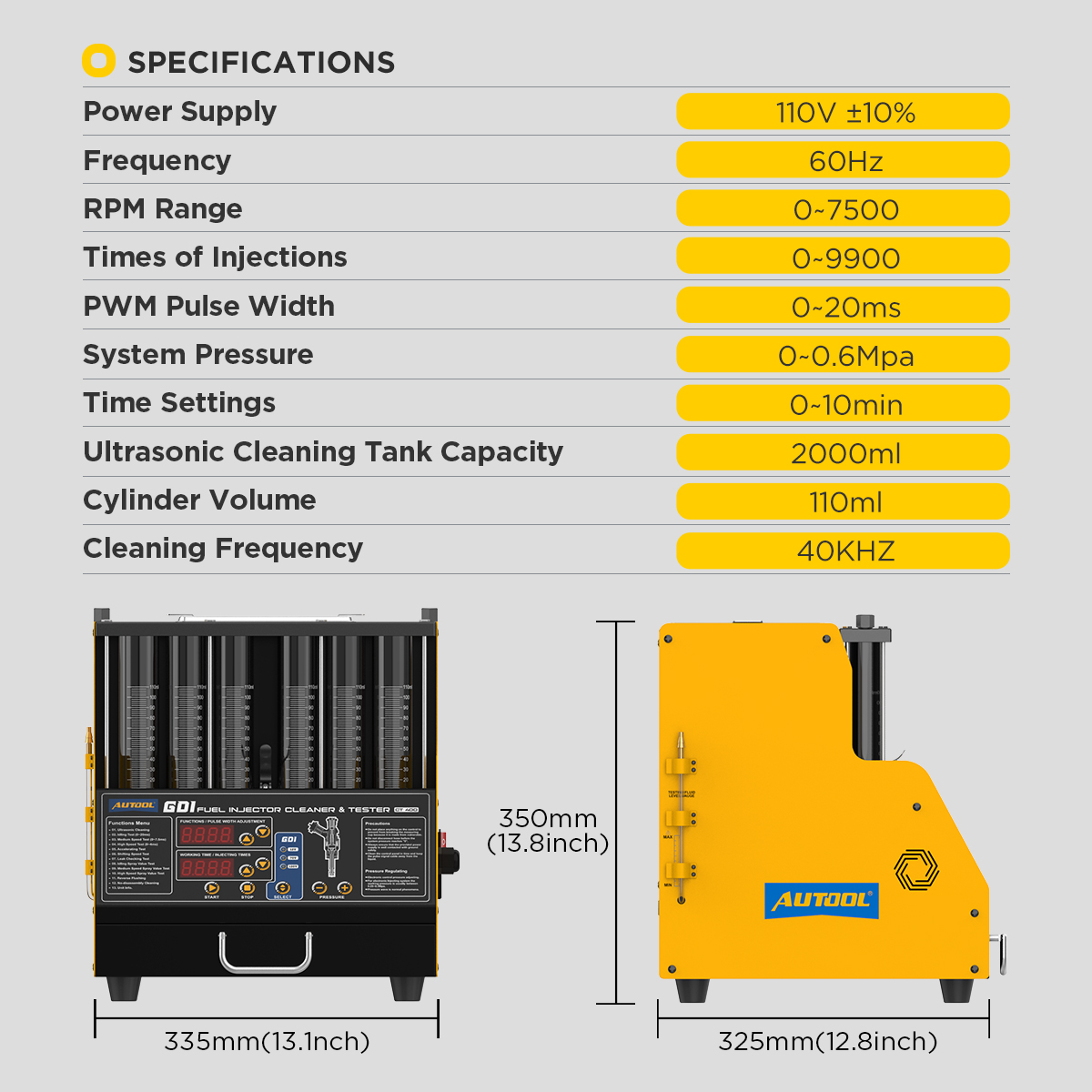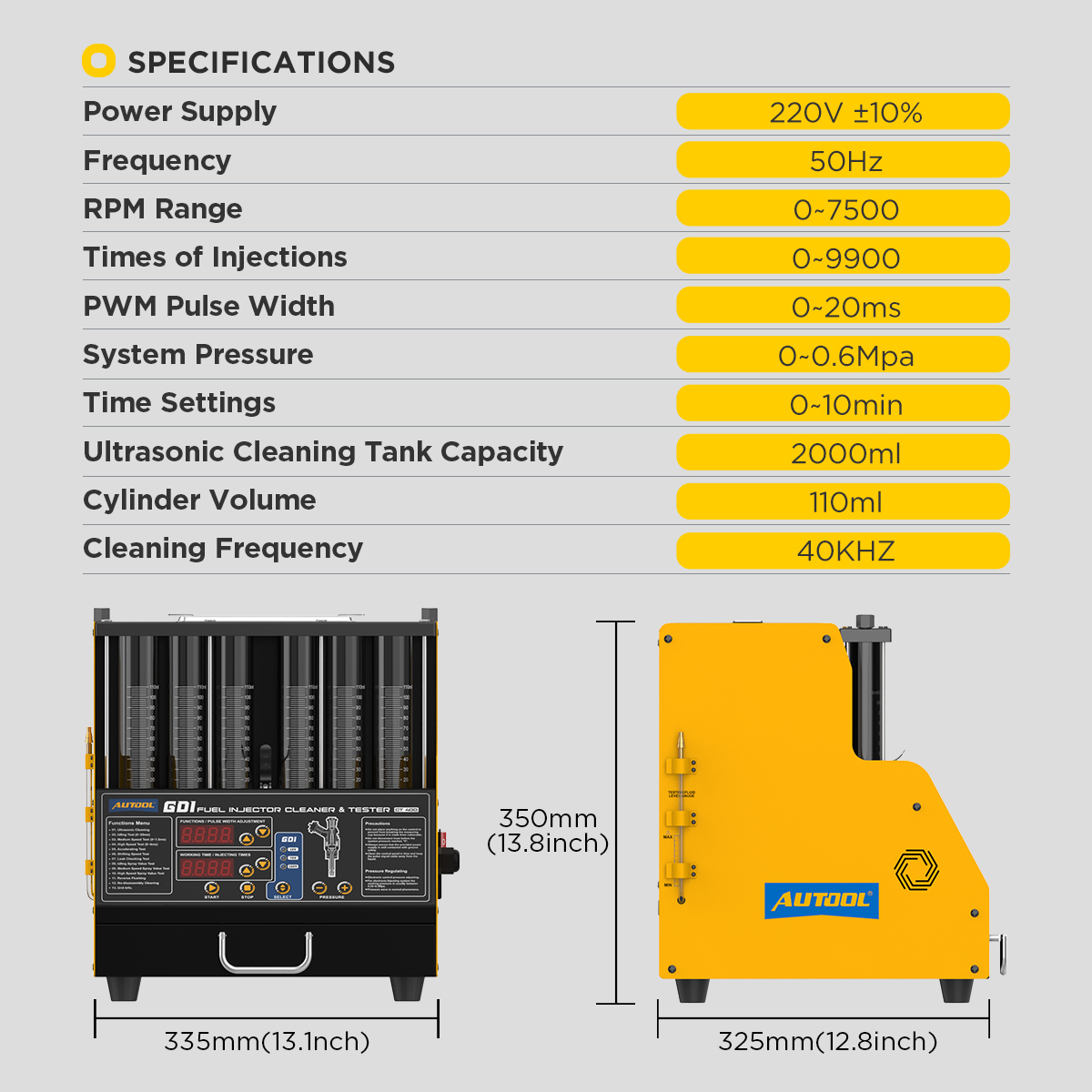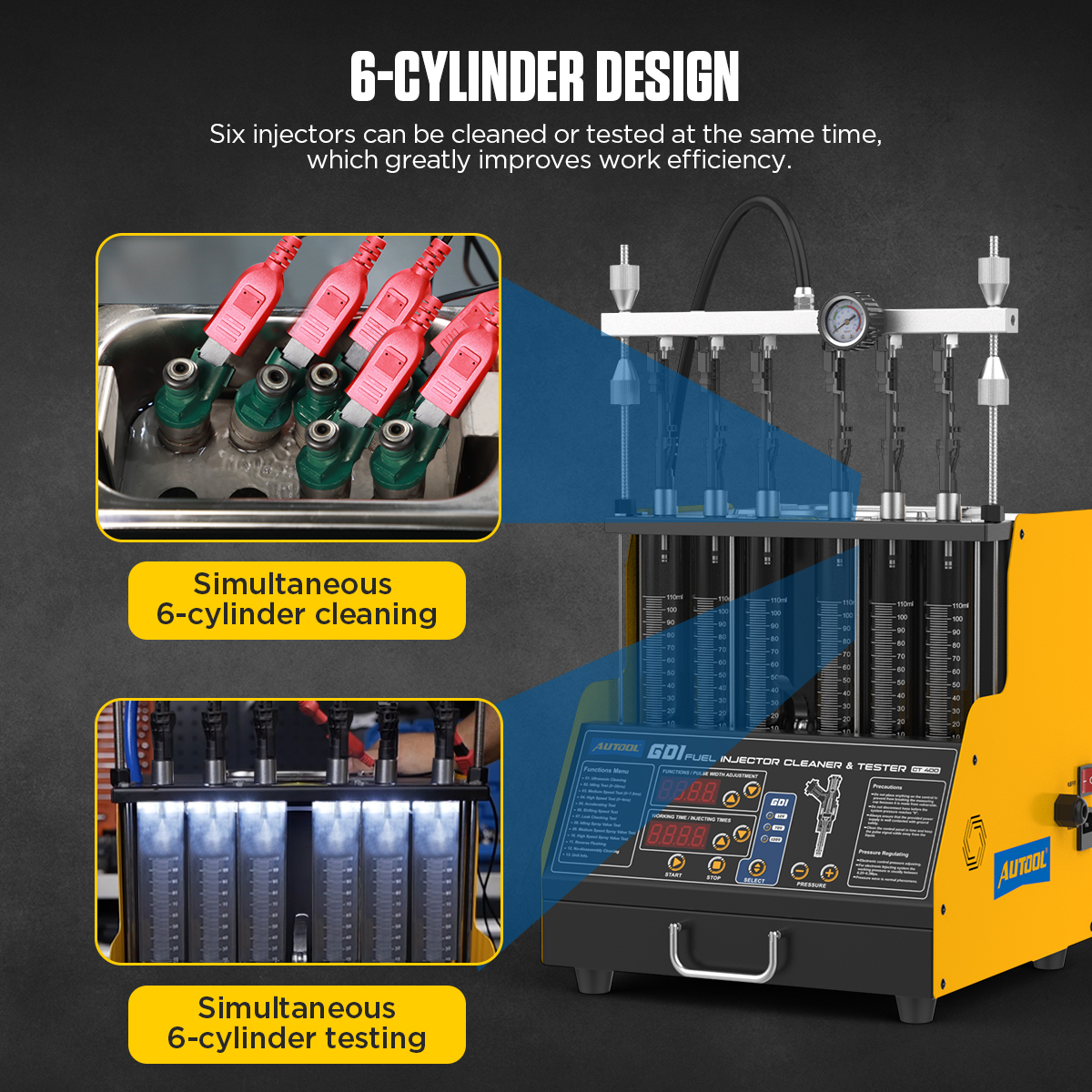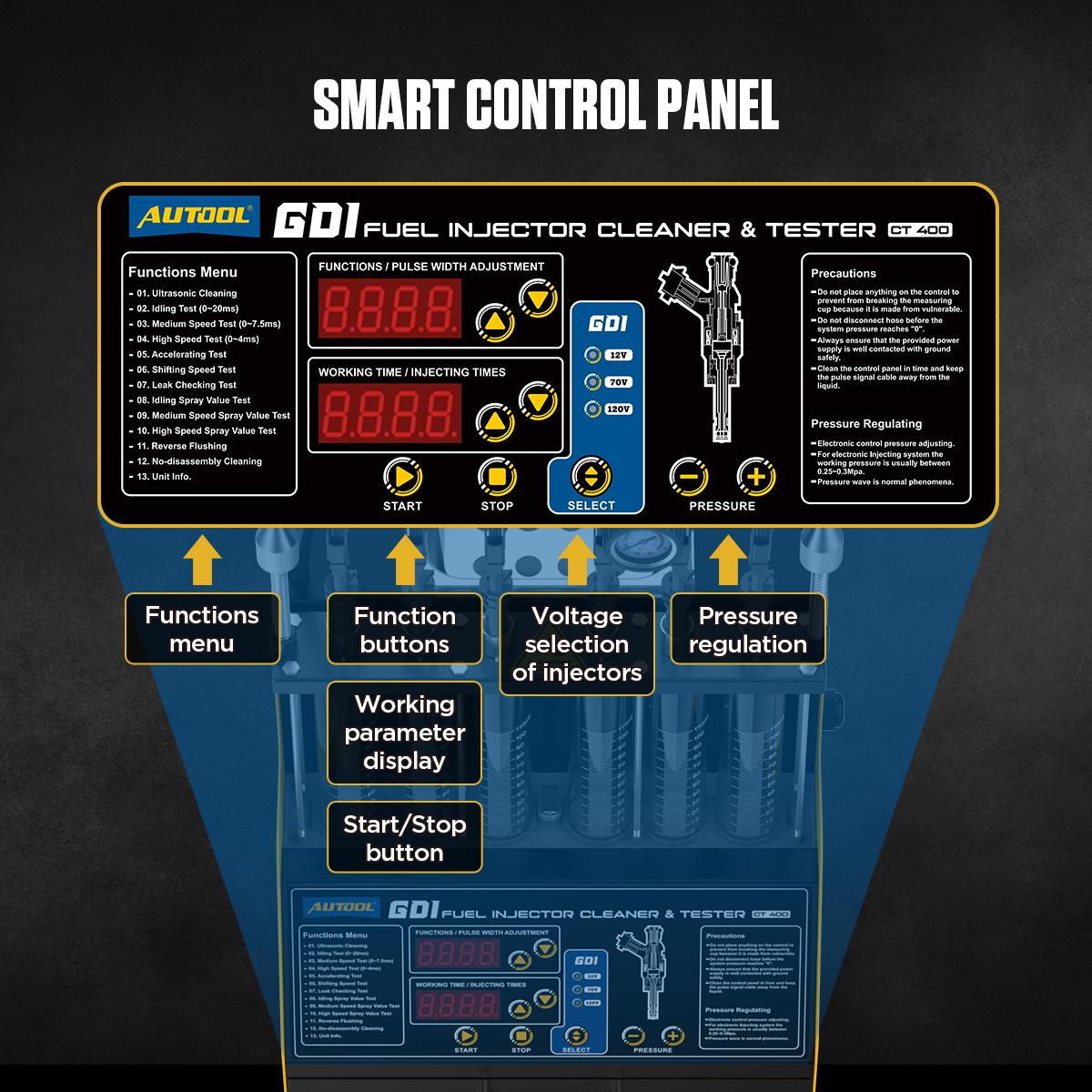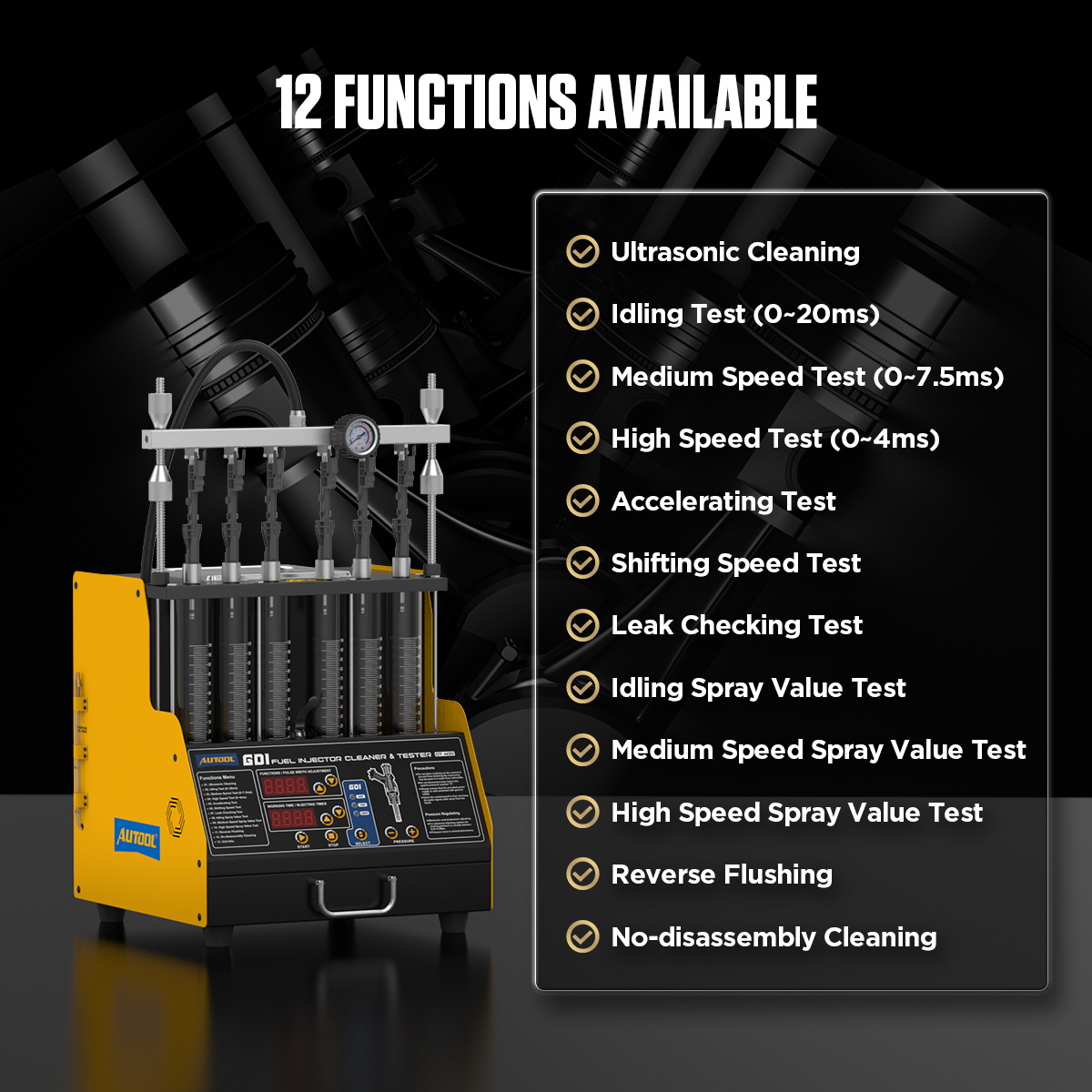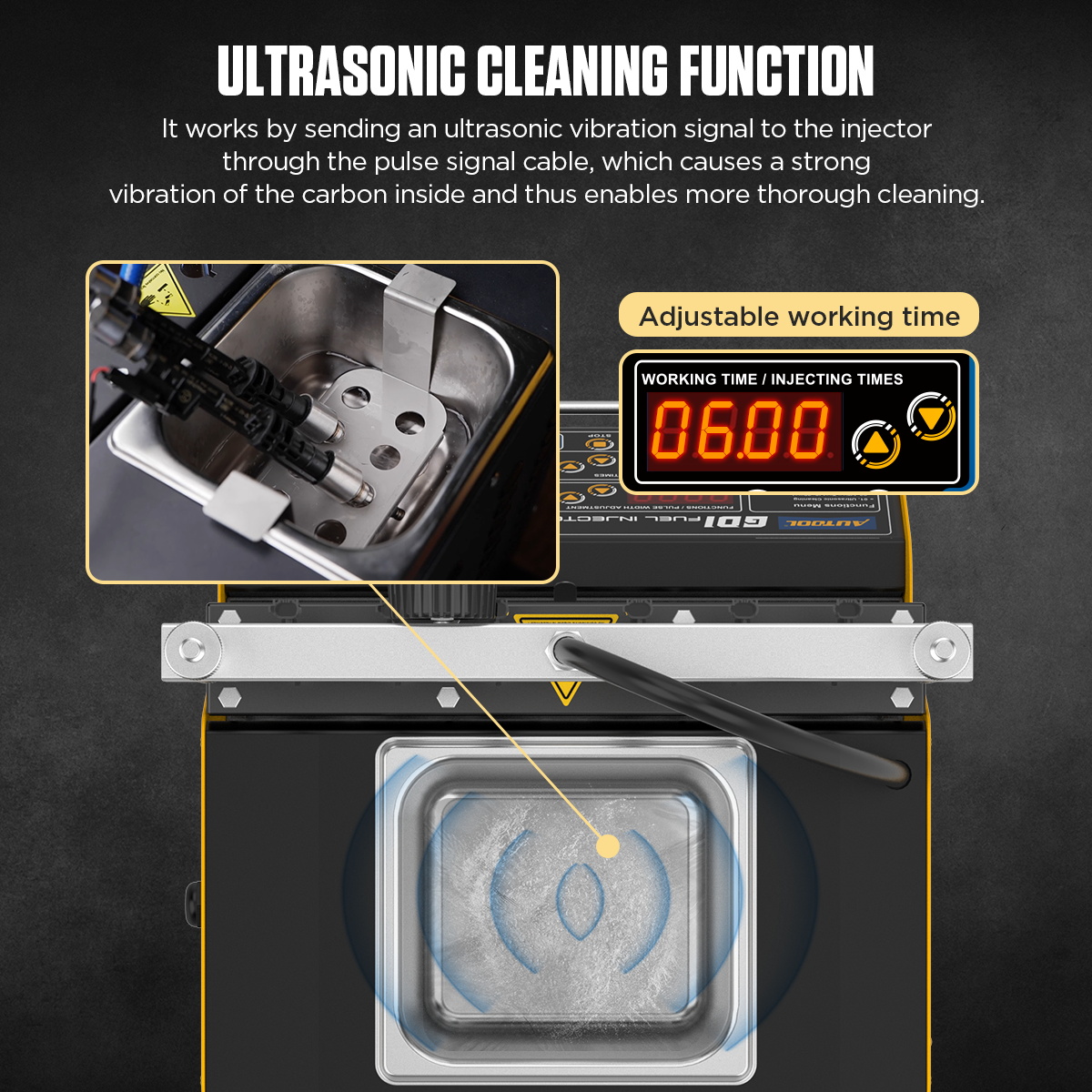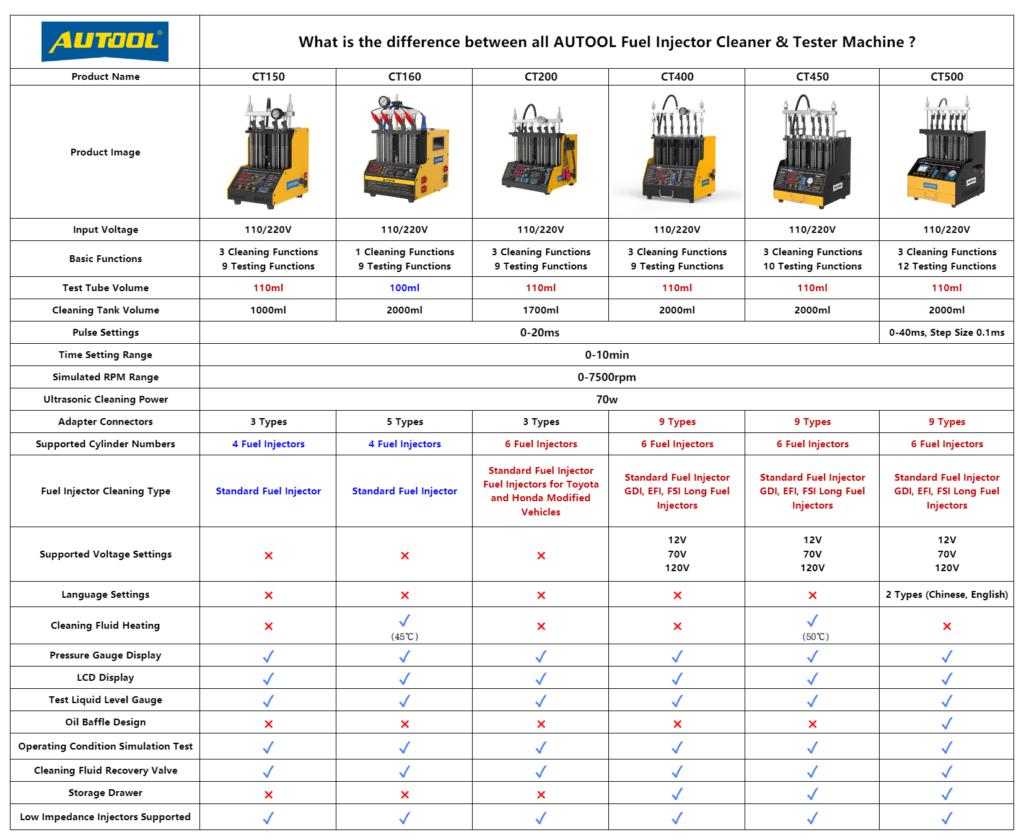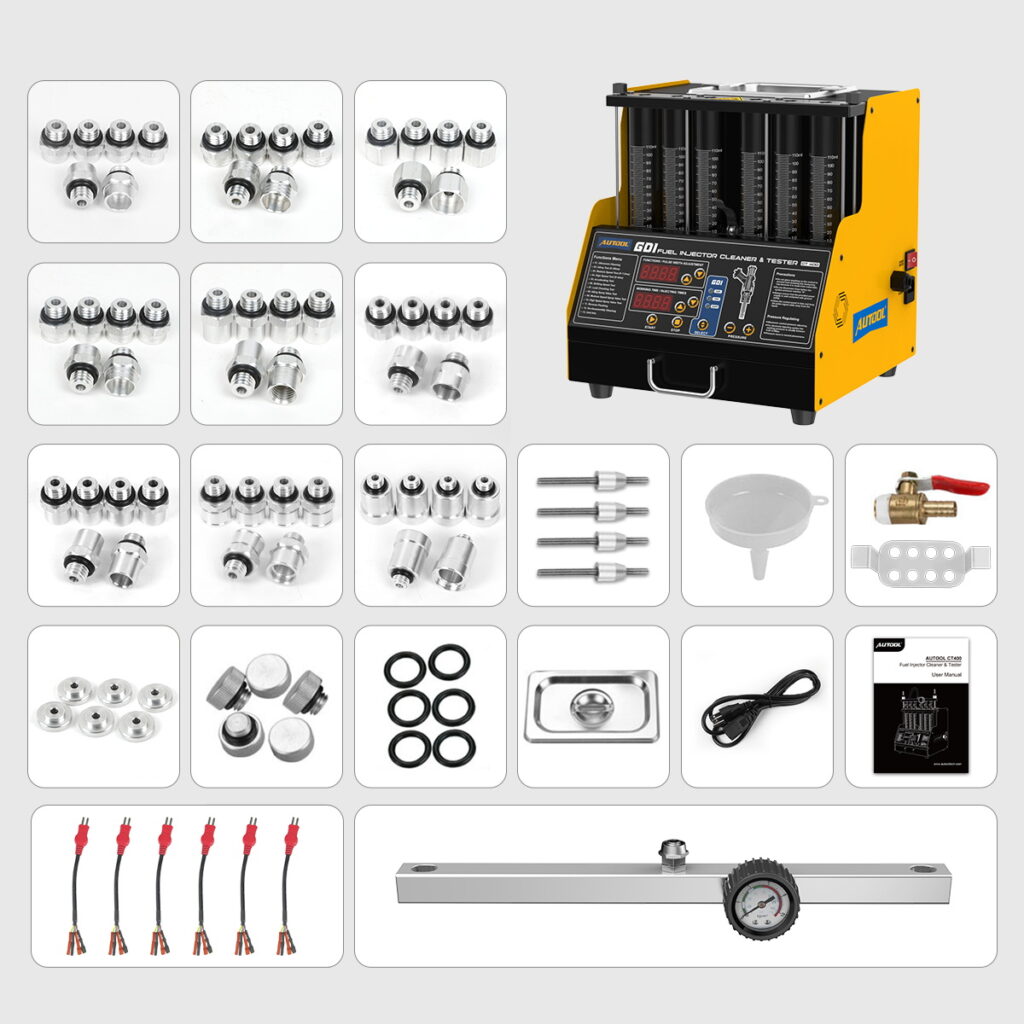Working Principle
The AUTOOL CT400 GDI Fuel Injector Cleaning Machine utilizes advanced GDI injector driving technology, precisely simulating the operation of gasoline direct injection (GDI) engines. GDI involves injecting fuel directly into the cylinder, where it mixes with intake air. Compared to traditional injection systems, this not only significantly enhances engine efficiency and power output but also effectively reduces exhaust emissions. The CT500 is equipped with an integrated GDI injector driving system that supports the cleaning and testing of various injector types, including GDI, EFI, FSI, and standard injectors. The equipment offers three voltage driving modes (12V, 70V, 120V) to meet the diverse needs of fuel injectors from mainstream automotive brands in Europe, America, and Asia, showcasing excellent compatibility and performance advantages.
AUTOOL CT400 GDI Fuel Injector Tester & Cleaner Features
9 Testing Functions
Idle Speed Test (0-20ms): Simulates engine idle speed operation to test the performance of the fuel injectors.
Medium-Speed Test (0-7.5ms): Simulates engine mid-speed operation to test the fuel injector performance.
High-Speed Test (0-4ms): Simulates engine high-speed operation to test the performance of the fuel injectors.
Acceleration Test: Simulates vehicle’s acceleration state to test the working performance of the fuel injectors.
Shift Speed Test: Simulates the vehicle’s gear-shifting state to test the working performance of the fuel injectors.
Leakage Check Test: Tests the sealing integrity of the fuel injectors.
Idle Spray Volume Test: Simulates the engine’s idle state to assess the atomization performance of the fuel injectors.
Medium-Speed Spray Volume Test: Simulates the engine’s medium-speed state to assess the atomization performance of the fuel injectors.
High-Speed Spray Volume Test: Simulates the engine’s high-speed state to assess the atomization performance of the fuel injectors.
Ultrasonic Deep Cleaning: The CT400 GDI fuel injector cleaning machine utilizes pulse signal cables to send signals to the fuel injectors, combined with cleaning fluid and ultrasonic vibration technology. This process efficiently removes carbon deposits and stubborn impurities inside the fuel injectors, ensuring thorough and deep cleaning.
Multi-Injector Cleaning and Testing: The CT400 Fuel Injector Tester & Cleaner features six independent glass tubes, enabling the simultaneous cleaning and testing of up to six injectors. This greatly enhances cleaning efficiency, streamlines the testing process, and ensures more convenient operation.
Reverse Cleaning Function: The AUTOOL CT400 GDI fuel injector cleaning machine utilizes cleaning fluid injected from the nozzle’s outlet to the inlet, effectively removing internal deposits and filter impurities. This feature is particularly suitable for top-feed fuel injectors, significantly enhancing the cleaning performance (only applicable to top-feed fuel injectors).
Non-disassembly Cleaning Function: With the help of a dedicated adapter, the fuel injectors can be cleaned directly without disassembly, making it convenient and quick, offering an additional cleaning option (this function requires the optional non-disassembly cleaning tool).
Smart Voltage Matching: The AUTOOL CT400 utilizes advanced GDI fuel injector drive technology, supporting 12V, 70V, and 120V high-voltage fuel injectors. The equipment is equipped with an smart voltage recognition function that automatically determines the required drive voltage for the injector. It triggers an alert in case of a voltage mismatch, ensuring safe and efficient operation.
Intelligent Cooling System: The AUTOOL CT400 GDI Fuel Injector Tester & Cleaner is equipped with an efficient cooling fan and thermal protection device, with 60W power supporting intelligent temperature control. During use, the cooling system automatically activates when the temperature becomes too high, effectively preventing overheating damage and significantly extending the equipment’s lifespan.
Intuitive Display Function: Equipped with a liquid level gauge for precise indication of the added test fluid volume, ensuring accurate test results. The pressure gauge provides real-time monitoring of test pressure, effectively preventing excessive pressure from damaging the equipment or injectors, ensuring safer and more reliable operation.
Convenient Liquid Recovery: Equipped with a cleaning fluid recovery valve for collecting used cleaning fluid, and a liquid level gauge to monitor the recovery (once the liquid level drops, the fluid can be recovered). This effectively prevents potential damage to the equipment caused by prolonged liquid residue. The recovered fluid can be reused, protecting the equipment and reducing operating costs, making it both economical and environmentally friendly.
Wide Compatibility: Compatible with various types of fuel injectors, including GDI, EFI, FSI, etc. It supports cleaning and testing of both standard injectors and three voltage driving modes (12V, 70V, 120V), providing professional solutions for the majority of vehicle models on the market.
Convenient Storage: The built-in small drawer allows for organized storage of various fuel injector adapters, making them easy to access and preventing parts from getting lost. The design is thoughtful and user-friendly.
Operating Instructions
Tips
1. Please use professional engine carbon cleaning fluid as the ultrasonic cleaning liquid to ensure effective cleaning and equipment safety.
2. When performing fuel injector testing, select professional test fluids and avoid using corrosive liquids. It is recommended to use anhydrous alcohol as the preferred option.
3. After use, promptly drain all fluids from the equipment and clean it properly to extend the machine’s lifespan.
Ultrasonic Cleaning
1. Clean the exterior of the injector with cleaning liquid before turning on the machine.
2. Once the exterior of the injector is free of dirt, place the injector into the ultrasonic cleaning tank.
3. Add cleaning liquid, ensuring that the liquid level does not exceed the connection port of the pulse pipeline.
4. Connect the pulse signal wire and select the first ultrasonic cleaning function to start.
5. Allow the ultrasonic cleaning function to run for deep cleaning.
6. After cleaning, recover the remaining cleaning liquid.
Fuel Injector Test
1. Secure the injectors onto the main unit and test the injector’s resistance, short circuit, and current.
2. Fill half of the glass tube with the testing solution.
3. Perform leak tests, spray mode tests, and flow rate tests on the flow bench.
4. Finally, place the injectors back onto the flow bench and retest all functions.



